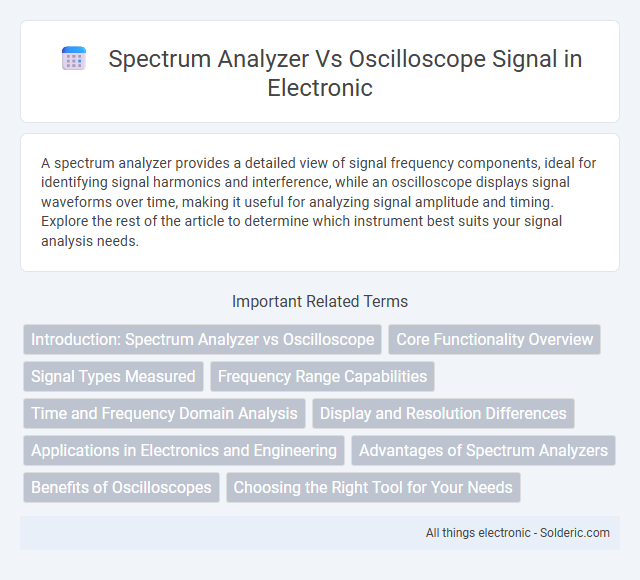A spectrum analyzer provides a detailed view of signal frequency components, ideal for identifying signal harmonics and interference, while an oscilloscope displays signal waveforms over time, making it useful for analyzing signal amplitude and timing. Explore the rest of the article to determine which instrument best suits your signal analysis needs.
Comparison Table
| Feature | Spectrum Analyzer | Oscilloscope |
|---|---|---|
| Primary Function | Frequency domain analysis | Time domain signal visualization |
| Signal Type | RF, audio, and electrical signal spectra | Voltage signals over time |
| Displayed Data | Amplitude vs frequency | Amplitude vs time |
| Measurement Focus | Signal frequency components and power | Signal waveform shape and timing |
| Typical Use Case | Wireless, communications testing, interference analysis | Signal troubleshooting, waveform integrity, timing analysis |
| Bandwidth | Wide, up to several GHz | Limited, depends on sampling rate (up to GHz range) |
| Resolution | Frequency and amplitude resolution (Hz and dB) | High time resolution (nanoseconds or better) |
| Data Representation | Frequency spectrum plot | Oscilloscope trace/waveform |
| Common Brands | Keysight, Rohde & Schwarz, Tektronix | Tektronix, Keysight, Rigol |
Introduction: Spectrum Analyzer vs Oscilloscope
Spectrum analyzers and oscilloscopes serve distinct purposes in signal analysis; spectrum analyzers measure signal power across frequency components, enabling identification of signal spectrum, harmonics, and interference, while oscilloscopes display signal amplitude over time, providing insight into waveform shape, timing, and transient events. Spectrum analyzers excel in frequency domain analysis, making them essential for RF design, interference hunting, and spectral compliance testing. Oscilloscopes offer detailed time-domain visualization crucial for digital signal debugging, timing analysis, and transient monitoring.
Core Functionality Overview
Spectrum analyzers focus on measuring signal amplitude across frequency domains, providing detailed insights into frequency components, harmonics, and spectral density. Oscilloscopes capture and display time-domain waveforms, allowing visualization of voltage signals over time for transient analysis and waveform characterization. Both instruments are essential for electronic signal analysis, but spectrum analyzers excel in frequency analysis while oscilloscopes specialize in time-based signal observation.
Signal Types Measured
Spectrum analyzers measure the frequency spectrum of radio frequency (RF), audio, and microwave signals, providing detailed information about signal amplitude versus frequency. Oscilloscopes capture time-domain waveforms of electrical signals, displaying voltage changes over time for analog, digital, and mixed-signal types. While spectrum analyzers excel in identifying signal harmonics and interference, oscilloscopes are ideal for observing signal shape, timing, and transient behavior.
Frequency Range Capabilities
Spectrum analyzers excel in frequency range capabilities, often covering from a few hertz up to several gigahertz, ideal for detailed frequency domain analysis of complex signals. Oscilloscopes typically have more limited frequency ranges, usually up to a few hundred megahertz or low gigahertz, focusing on time-domain signal visualization. Your choice depends on whether you need in-depth frequency spectrum insights or precise time-domain waveform measurements.
Time and Frequency Domain Analysis
Spectrum analyzers excel in frequency domain analysis by displaying signal amplitude versus frequency, allowing precise identification of signal components and harmonics. Oscilloscopes provide time domain analysis by graphing voltage versus time, enabling detailed observation of waveform shapes, timing, and transient events. Understanding both tools enhances your ability to analyze signals comprehensively, combining frequency insights with temporal behavior.
Display and Resolution Differences
Spectrum analyzers display signals as amplitude versus frequency, providing detailed frequency domain information with high resolution and accuracy for identifying signal components and harmonics. Oscilloscopes show signal amplitude versus time, offering high time-domain resolution ideal for analyzing waveform shape, timing, and transient events. The resolution of a spectrum analyzer depends on parameters like resolution bandwidth (RBW), while an oscilloscope's resolution is influenced by its sampling rate and vertical sensitivity.
Applications in Electronics and Engineering
Spectrum analyzers are essential in electronics and engineering for frequency domain analysis, enabling precise measurement of signal spectral components, interference detection, and harmonic distortion evaluation in RF and communication systems. Oscilloscopes excel in time-domain analysis, providing detailed visualization of voltage waveforms, signal timing, and transient events critical for circuit debugging, waveform integrity, and digital signal verification. Both instruments complement each other by offering comprehensive insights into signal behavior, enhancing design optimization and fault diagnosis in complex electronic systems.
Advantages of Spectrum Analyzers
Spectrum analyzers provide precise frequency domain analysis by displaying signal amplitude versus frequency, enabling identification of signal components, harmonics, and interference that oscilloscopes cannot resolve effectively. They offer superior dynamic range and sensitivity for detecting weak signals within crowded spectral environments, essential for RF and wireless communication testing. Additionally, spectrum analyzers facilitate modulation analysis and spectral purity measurements, crucial for compliance testing and signal integrity verification.
Benefits of Oscilloscopes
Oscilloscopes provide real-time visualization of signal waveforms, enabling precise measurement of voltage changes over time and detailed analysis of transient events. Their ability to display time-domain signals makes them essential for troubleshooting circuit behavior, identifying irregularities like glitches, and verifying timing relationships in complex electronic systems. Unlike spectrum analyzers, oscilloscopes excel in capturing fast, non-repetitive signals and offering immediate insight into signal integrity and noise characteristics.
Choosing the Right Tool for Your Needs
Spectrum analyzers excel in frequency domain analysis, providing detailed amplitude vs. frequency data essential for signal characterization, interference detection, and spectral efficiency assessment. Oscilloscopes offer time-domain visualization, capturing signal waveforms and transient events critical for time-based troubleshooting and waveform integrity verification. Selecting the right tool depends on whether you need frequency spectrum insights or time-resolved signal behavior, aligning with the specific diagnostic or measurement requirements of your electronic project.
Spectrum analyzer vs oscilloscope signal Infographic

 solderic.com
solderic.com